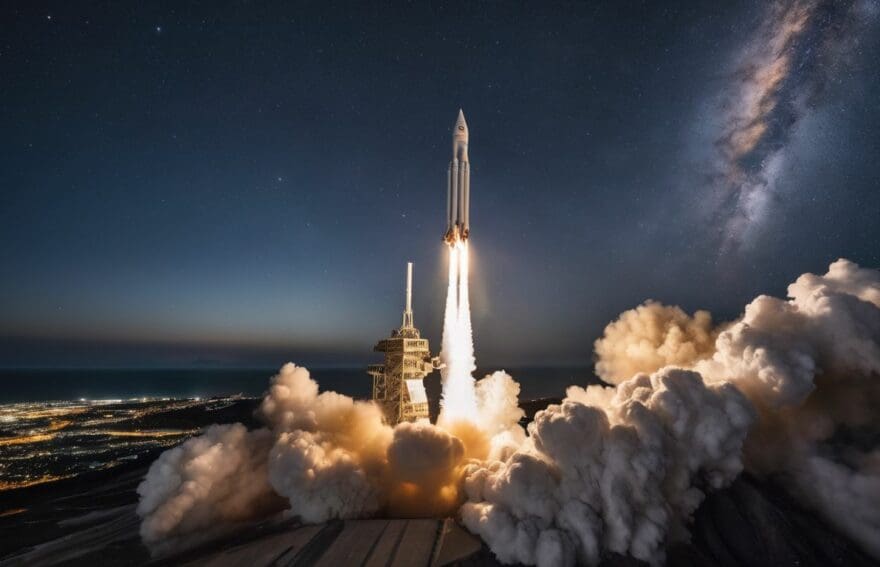Kerbal Space Program: Launching into Space with a Bang

Updated On: November 25, 2025 by 
Embarking on the boundless expanse of the cosmos within Kerbal Space Program can be a bit of a sticky wicket for fresh-faced space commanders and grizzled astronauts alike. Rest assured, we’ve all found ourselves hesitating at the launchpad’s edge – but fear not! Armed with our meticulous research and countless trial-and-error escapades, we’re poised to shepherd you through this celestial odyssey.
Consider our article your trusty companion: an invaluable treasure map that will shepherd you from mission control to the dance of distant stars — imparting critical knowledge on constructing steadfast rockets, mastering staging finesse, and achieving gentle touchdowns.
Brace yourself for an exhilarating ascent!
Understanding the Basics of Kerbal Space Program
When it comes to understanding the basics of Kerbal Space Program, there are a few key things to keep in mind. From getting started with the game to learning about rocket specifications, we’ll cover all you need to know as a beginner.
Walkthrough for Beginners
We’ve all been beginners at some point, so let’s dive into the vibrant world of Kerbal Space Program. This walkthrough will guide you through your first steps to becoming a rocket science whiz.
- Start by selecting the Kerbal X rocket available on the Launch Pad; it’s a premade option perfect for newcomers.
- Familiarise yourself with the game’s interface and get to know different control panels within the space centre operations.
- Check out the Kerbal Space Program Wiki for valuable insights that can significantly ease your learning curve.
- Review the comprehensive guide provided in PDF format to understand complex orbital mechanics and spacecraft control.
- Plan your missions with an emphasis on return strategies, especially when launching into higher orbits like 200km.
- Pay attention to your Thrust to Weight ratio; aim for 1.5 to 2.0 when launching heavier rockets to avoid complications from high G forces.
- Engage stages carefully during liftoff, making sure engine ignition and rocket propulsion are successfully initiated before progressing further.
- Practise gravity turns strategically after leaving the launch pad to establish an efficient orbital trajectory around Kerbin.
- Remember that successful space exploration requires both technical knowledge and creative problem-solving skills; don’t hesitate to experiment.
Specifications
Understanding the specifications of Kerbal Space Program helps both experts and novices set the right expectations for their space exploration journey. The game’s spec requirements are essential for a smooth experience.
| Specification | Requirement |
|---|---|
| Operating System | Windows 7 64-bit or later / macOS / Linux |
| Processor | Core 2 Duo or equivalent |
| Memory | 4GB RAM |
| Graphics | DX10 (SM 4.0) capable, 512MB VRAM |
| Hard Drive Space | 3GB |
| DirectX | Version 9.0c |
These ensure your computer can handle the game’s demands. Considering the upcoming Early Access launch on Feb. 24, it’s wise to prepare your system for the new features, including interstellar exploration. Remember, the Kerbal X is a great starting point for beginners, easing you into the thrill of launching rockets. Keep in mind the Thrust to Weight ratio; 1.5 to 2.0 is ideal for heavier rockets. This prevents unwanted failures when you command your Kerbals into the unknown.
Your First Launch
Starting the game is an exciting experience, and launching from the pad requires careful planning and execution. We’ll provide some tips for success to help you get off the ground smoothly.
Starting the Game
Upon starting the game, we recommend using the premade rocket called the Kerbal X (Stock) at the Launch Pad. This will help you familiarise yourself with the basics of rocket launch and manoeuvring in space.
Players should also pay attention to the optimal Thrust to Weight ratio for launching heavier rockets, ensuring a smoother ascent without risking failures caused by higher G forces.
Additionally, beginners can seek guidance from the Kerbal Space Program Wiki as they navigate through their first few hours with the game.
Now that we have our rocket ready, it’s time to take off into outer space and embark on our thrilling journey!
Launching from the Pad
To launch from the pad, we begin by selecting our spacecraft and crew. Next, we ensure that all systems are go and prepare for liftoff. Once ready, we ignite the engines to start ascending into the sky. We carefully monitor our speed and trajectory, making any necessary adjustments along the way. As we soar towards space, we maintain focus on reaching the designated altitude for orbit insertion. Finally, we celebrate a successful launch as we break through Earth’s atmosphere and head into the great unknown.
Tips for Success
Here are some tips for success to ensure a safe and successful launch into space:
- Choose the right rocket with a thrust to weight ratio of 1.5 to 2.0 to prevent failures caused by higher G forces.
- Prioritise staging and execute gravity turns at the appropriate time during the launch.
- Ensure stability by making adjustments to your spacecraft during ascent using control surfaces or reaction wheels.
- Be mindful of atmospheric conditions and aim for an optimal trajectory to reach orbit efficiently.
- Plan and manage your return trip, especially when launching into a 200km orbit, to ensure a safe journey back to Kerbin.
Achieving Orbit
Choosing the right rocket and mastering staging and gravity turns are essential for reaching orbit in Kerbal Space Program. Once you understand these techniques, you’ll be well on your way to exploring the vastness of space.
Choosing the Right Rocket
When selecting the right rocket for your mission in Kerbal Space Program, it’s crucial to consider the specific requirements of your payload. We must take into account the mass, desired altitude, and thrust-to-weight ratio needed for a successful launch.
In addition to this, we should always aim for a balance between power and efficiency, ensuring that our rocket is capable of reaching our intended orbit without wasting excess fuel.
Considering various factors such as the optimal Thrust to Weight ratio and available payload space will greatly impact our success in launching our spacecraft. It’s important to carefully assess these elements before making any decisions regarding which rocket will best suit our mission requirements.
By doing so, we can increase the likelihood of achieving a successful launch with minimal setbacks.
Staging and Gravity Turns
- Activate Staging: Players can activate different stages of their rocket during launch to ensure a smooth trajectory and minimise fuel wastage.
- Implement Gravity Turns: Utilise the technique of gravity turns to gradually tilt the rocket sideways during ascent, allowing for efficient use of fuel and achieving a stable orbit.
- Optimise Trajectory: By mastering both staging and gravity turns, players can optimise their rocket’s trajectory, ensuring a successful journey into space with minimal complications.
- Manage Fuel Consumption: Proper execution of staging and gravity turns is crucial for managing fuel consumption effectively throughout the ascent, enabling a safe and stable flight.
- Attain Orbit: By skilfully implementing staging and gravity turns, players can navigate their spacecraft towards achieving a stable orbit around celestial bodies within the game environment.
- Enhance Gameplay Strategy: Understanding the mechanics behind staging and gravity turns provides players with an opportunity to enhance their overall strategy in Kerbal Space Program, leading to more successful space missions.
Reaching Orbit
After mastering staging and gravity turns, the next challenge is reaching orbit. Here are some essential tips to achieve this milestone:
- Select the right rocket: Choose a rocket with enough power and fuel to reach orbit.
- Time your burn: Start burning your engine when you’re about 45 degrees from prograde, and continue until you achieve orbital velocity.
- Manage apoapsis: Aim to circularise your orbit when you reach an altitude of around 75-100 km.
- Monitor fuel consumption: Ensure that you have sufficient fuel to complete the burn and maintain your orbit.
- Create a stable trajectory: Adjust your direction as needed to maintain a stable orbit.
Advanced Techniques
Mastering the art of staying stable in space can be a challenge, but with our expert tips and techniques, you’ll be well on your way to becoming a Kerbal Space Program pro. Read on for more advanced strategies to take your gameplay to the next level!
Avoiding the Atmosphere
When launching a rocket in Kerbal Space Program, achieving orbit requires avoiding the atmosphere. To do this, players need to ensure their rocket reaches a speed of at least 2,200 meters per second while ascending through the atmosphere.
Additionally, it is essential to angle the rocket gradually upwards during ascent and perform a gravity turn to avoid excessive drag from the Earth’s atmosphere. By employing these techniques and paying attention to staging, players can effectively guide their rockets into space.
To successfully navigate out of the atmosphere in Kerbal Space Program, mastering effective staging and executing precise gravity turns are crucial. Achieving these milestones is critical for success in reaching orbit and beyond.
Returning from Orbit
- Monitor your spacecraft’s trajectory and use the game’s tools to predict its path during re-entry.
- Reduce your speed gradually by entering the atmosphere at a shallow angle to minimise heat and stress on your spacecraft.
- Watch for the onset of atmospheric effects as you descend and adjust your trajectory to ensure a safe landing.
- Deploy parachutes at the right altitude to slow down further and guide your craft safely back to the surface.
- Take into account any potential hazards such as mountains or rough terrain when selecting a landing spot.
- Utilise the game’s autopilot or manual controls to steer your craft gently towards a suitable touchdown area.
- Keep an eye on your velocity and make small adjustments as needed while aiming for a smooth landing.
Tips for Staying Stable
To stay stable during your space exploration in Kerbal Space Program, follow these tips:
- Check your rocket’s centre of mass and make sure it is aligned with the thrust vector to prevent any unwanted rotation.
- Utilise reaction wheels to help maintain stability by controlling your spacecraft’s rotation.
- Keep an eye on the aerodynamic forces acting on your craft and adjust accordingly to maintain stability during flight.
- Employ control surfaces such as fins and wings to aid in stabilisation and control while manoeuvring through different atmospheric conditions.
- Use SAS (Stability Augmentation System) to assist in maintaining stability by automatically adjusting control surfaces and thrust vectoring.
- Ensure correct staging of rocket components to avoid imbalance that could lead to instability during launch or re-entry.
- Pay attention to the throttle setting of your rocket engine, adjusting it as needed for smoother ascent and descent manoeuvres.
Conclusion
Embark on your space journey with Kerbal Space Program. Master the basics and conquer gravity to launch into orbit. Explore the depths of space with confidence and skill. Take charge, ignite those rockets, and blast off! Experience the wonders of interstellar travel in a game like no other.
FAQs
1. What is the Kerbal Space Program?
The Kerbal Space Program is a space simulation game where players manage their own space program, design spacecraft, and launch astronauts into orbit.
2. Can you learn about spacecraft propulsion in this game?
Yes, the game teaches players about spacecraft propulsion and other aspects of astronaut training through interactive gameplay.
3. Is Kerbal Space Program just for fun, or can it teach me how to build a real space shuttle?
While it’s a lot of fun, the Kerbal Space Program also offers valuable insights into space shuttle construction and operation that mirror real-life space missions.
4. Does playing this game feel like running an actual space program?
Absolutely! When playing Kerbal Space Program: Launching into Space with a Bang, you get an authentic experience of what it’s like to run a full-fledged space program simulation.









